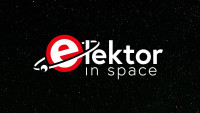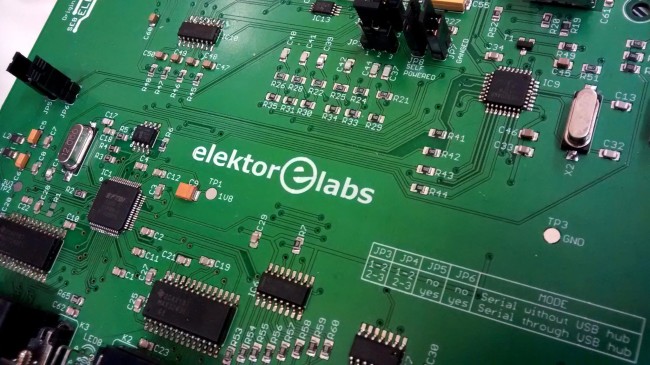Elektor in Space: Think and Design with Us About the IoST

Elektor is thinking about launching a satellite of its own and/or adding some tech to a partner's future launch. Think along with us about the IoST, a potential satellite launch, space electronics, and possible applications.
WELCOME! Yes, the "Internet of Space Things (IoST)" is a real thing! It might seem a bit "out there" today, but many of you will remember how fast the IoT caught on. In typical Elektor fashion, our managing director has challenged our in-house engineers and editors to begin thinking ahead of the curve. And so, we are. In the coming days and weeks, the Elektor team will use this page to brainstorm about a potential satellite launch and the development of space-related projects and initiatives. Here we can share ideas and collaborate with you, the Elektor Labs community. No ideas or questions relating to space electronic are out of bounds.

++ October 2023 - Updates ++
The Elektor Lab Team is researching satellite options and brainstorming about the possibilities for data acquisition. Following up on our search in August and September, the team will look to order an Ambasat to study the hardware. We are also open to other ideas. Please share below.
In other news ... The 2023/2024 European Astro Pi Challenge is underway. Registration for the Mission Space Lab program is open from November 6, 2023, until February 19, 2024. If you are involved in the program, please notify Elektor's editorial team by email (editor at elektor.com)
And here are some upcoming space-related events. If you are attending any of these events (or any others), please let us know.
++ August - September 2023 - Give Us Your Input - How Do You Learn? ++
++ June 26, 2023 - AmbaSat ++ Elektor has begun the process of looking at a variety of space electronics-related projects and opportunities. For instance, a few days ago, a few of the engineers and editors at Elektor met with
AmbaSat's Khurram Hussain to discuss low-Earth orbit (LEO) opportunities, such as contributing to a Cube Satellite (CubeSat) launch in the fairly near future.
CubeSats can be used for a wide range of purposes, including scientific research, Earth observation, communications, education, and commercial applications. During our discussion with Hussain, we discussed AmbaSat's current offerings, as well as the sorts of applications its customers are prepping for future launches. At this time, if we decide to use an AmbaSat kit, or something similar, we'd have the ability to choose some sensors for our satellite. We would monitor the output with a dashboard.
The AmbaSat-1 PCB (Source: AmbaSat-1 Build Guide)For reference, note that each ATmega328-based AmbaSat Kit ships with gyroscope, accelerometer and magnetometer sensors (LSM9DS1 chip). Take a look at the schematic, which is included in the AmbaSat-1 Build Guide.
Mainboard schematic (Source: AmbaSat-1 Build Guide)You can also select an additional sensor. According to AmbaSat, the sensor range includes the following:
As we consider temperature-, light-, gas-, and pressure-related applications, we would appreciate your feedback. What sort of applications would you like to implement? Please use the Discussion space to brainstorm along with us.
++ April 11, 2023 - Poll ++
++ April 7, 2023 - Kickoff ++ Let's kick things off with a few triggering questions. Please share your thoughts in the Discussion section below.
Some interesting space electronics-related content. Share your thoughts.

Subscribe
Tag alert: Subscribe to the tag space and you will receive an e-mail as soon as a new item about it is published on our website! ++ October 2023 - Updates ++
The Elektor Lab Team is researching satellite options and brainstorming about the possibilities for data acquisition. Following up on our search in August and September, the team will look to order an Ambasat to study the hardware. We are also open to other ideas. Please share below.
In other news ... The 2023/2024 European Astro Pi Challenge is underway. Registration for the Mission Space Lab program is open from November 6, 2023, until February 19, 2024. If you are involved in the program, please notify Elektor's editorial team by email (editor at elektor.com)
And here are some upcoming space-related events. If you are attending any of these events (or any others), please let us know.
- Silicon Valley Space Week 2023 - October 17-18, 2023. https://svsw.events/
- 2023 ASCEND - Monday, October 23 – Wednesday, October 25 - https://www.ascend.events/
- 17th ESPI Autumn Conference: “European Space Governance in a Transforming World” - Tuesday, October 24 @ 12:00 pm – Wednesday, October 25 @ 2:00 pm - https://www.espi.or.at/17th-espi-autumn-conference/
- ESA Annual Conference on Commercial Space Exploration- Thursday, November 2 - Friday, November 3 - https://bsgn.esa.int/space-for-inspiration-2024/Stay tuned for more info!
++ August - September 2023 - Give Us Your Input - How Do You Learn? ++
++ June 26, 2023 - AmbaSat ++ Elektor has begun the process of looking at a variety of space electronics-related projects and opportunities. For instance, a few days ago, a few of the engineers and editors at Elektor met with
AmbaSat's Khurram Hussain to discuss low-Earth orbit (LEO) opportunities, such as contributing to a Cube Satellite (CubeSat) launch in the fairly near future.
CubeSats can be used for a wide range of purposes, including scientific research, Earth observation, communications, education, and commercial applications. During our discussion with Hussain, we discussed AmbaSat's current offerings, as well as the sorts of applications its customers are prepping for future launches. At this time, if we decide to use an AmbaSat kit, or something similar, we'd have the ability to choose some sensors for our satellite. We would monitor the output with a dashboard.
The AmbaSat-1 PCB (Source: AmbaSat-1 Build Guide)For reference, note that each ATmega328-based AmbaSat Kit ships with gyroscope, accelerometer and magnetometer sensors (LSM9DS1 chip). Take a look at the schematic, which is included in the AmbaSat-1 Build Guide.
Mainboard schematic (Source: AmbaSat-1 Build Guide)You can also select an additional sensor. According to AmbaSat, the sensor range includes the following:
- Sensor 01: SHT30-DIS-F2.5KS - Humidity and Temperature - An accuracy of 1.5 %RH and 0.1°C. Fast start-up and measurement time. A tiny 8-Pin DFN package.
- Sensor 02: STS21 - Temperature – A 3 × 3 mm, low-power, fully calibrated digital temperature sensor.
- Sensor 03: BME680 - Gas, Pressure, Temp & Humidity – A four-in-one multifunctional MEMS environmental sensor used for environmental monitoring, home automation/control, IoT, and more.
- Sensor 04: OPT3001DNPT - Ambient Light Sensor – The OPT3001 measures the intensity of visible light.
- Sensor 05: ZMOD4410AI1V - Total Volatile Organic Compounds (TVOC) – Designed for detecting TVOC, the ZMOD4410 consists of a gas sense element and a CMOS signal conditioning IC.
- Sensor 06: SI1132-A10-GMR - UV Sensor – The Si1132 is a low-power, UV index, and ambient light sensor with I2C digital interface and programmable-event interrupt output.
- Sensor 07: CCS811B-JOPD500 - TVOC & CO2 – The CCS811 is an ultra-low power digital gas sensor solution that integrates a MOX gas sensor to detect a wide range of Volatile Organic Compounds (VOCs). It includes an ADC and an I²C interface.
- Sensor 08: TESEO-LIV3R - GPS – The compact (9.7 × 10.1 mm) Teseo-LIV3R module is a GNSS standalone positioning receiver IC working simultaneously on multiple constellations. The certified module includes optimized RF and embedded firmware.
As we consider temperature-, light-, gas-, and pressure-related applications, we would appreciate your feedback. What sort of applications would you like to implement? Please use the Discussion space to brainstorm along with us.
++ April 11, 2023 - Poll ++
++ April 7, 2023 - Kickoff ++ Let's kick things off with a few triggering questions. Please share your thoughts in the Discussion section below.
- Are you interested in space electronics? Let us know what's on your mind.
- Do you have any aerospace experience? Please share details.
- Are you currently working on a space-related initiative? Please share details.
- Can you recommend useful space-related resources for engineers and makers interested in getting involved with satellite launches and the development of electronic tools for space science applications? Please share details.
Some interesting space electronics-related content. Share your thoughts.
- Subscribe to Elektor's "Space" tag for up-to-date notifications.
- Info on the Internet of Satellite Things (IoST)
- The IoT space race and CubeSats
- NB-IoT Connectivity from Space



Discussion (11 comments)